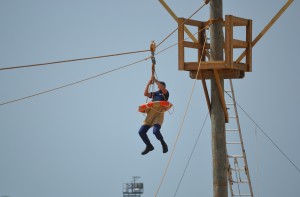
OCEAN CITY – Beachgoers got a glimpse of the challenges faced by early lifesaving crews as Ocean City hosted a reenactment last weekend to celebrate the 100th anniversary of the U.S. Coast Guard.
Last Saturday, visitors and local officials gathered around a cordoned-off area of the Inlet beach to watch volunteers perform a breeches buoy reenactment, one of the rescue methods employed in the early days of the Coast Guard. The demonstration illustrated the way passengers were rescued from ships at sea during the 19th and early 20th century.
“This shows what it would have been like when you didn’t have engines,” said Nancy Howard, president of the Ocean City Museum Society. “You didn’t have mechanics. This is what they had to do. It brings attention to a part of the history of Ocean City that people might not associate with Ocean City.”
Howard, a former Ocean City Council member, said the reenactment was a great way to share a piece of Ocean City history and at the same time commemorate the 100th anniversary of the Coast Guard, which has had a presence in Ocean City since before it formally became the U.S. Coast Guard in 1915.
On Saturday, Lowell Markey of Delaware Seashore State Park narrated as a group of volunteers and current members of the Coast Guard reenacted a rescue similar to those that took place in Ocean City until as recently as 1941. According to Markey, until the mid-1800s there was no organization responsible for helping people involved in ship wrecks. Eventually though, life-saving stations were established.
Markey said the crews who manned those stations used two rescue methods — the surf boat and the breeches buoy. When possible, they rode the surf boat out to the ship in trouble and brought its passengers to shore. That wasn’t always feasible though, as most ship wrecks occurred during the winter.
“Imagine 30 degree temperatures,” Markey said. “Twelve foot waves. Forty to 50 mph winds. That surf boat was quite dangerous to launch.”
In those conditions, the easiest way to rescue passengers from a wrecked ship was to use a cannon to shoot a line out to the boat. Attached to it were instructions for the passengers to wrap it around the ship’s mast. Using a pulley system, rescuers would then send out a rescue buoy with an attached leg harness similar to a pair of breeches. Passengers were able to climb into the breeches, which made staying attached to the buoy possible in heavy surf conditions, and slide along the rope to shore.
Markey said the breeches buoy played a key role in water rescues until the mid-19th century.
“It made a world of difference,” he said.
The equipment used in Saturday’s presentation was borrowed from the Indian River Life-Saving Station Museum. In Delaware, the breeches buoy rescue drill is performed several times each summer.
Howard said she hoped to see it take place in Ocean City again in the future as Saturday’s reenactment was well received.
“The turnout was terrific,” she said. “We were delighted with the whole event.”

